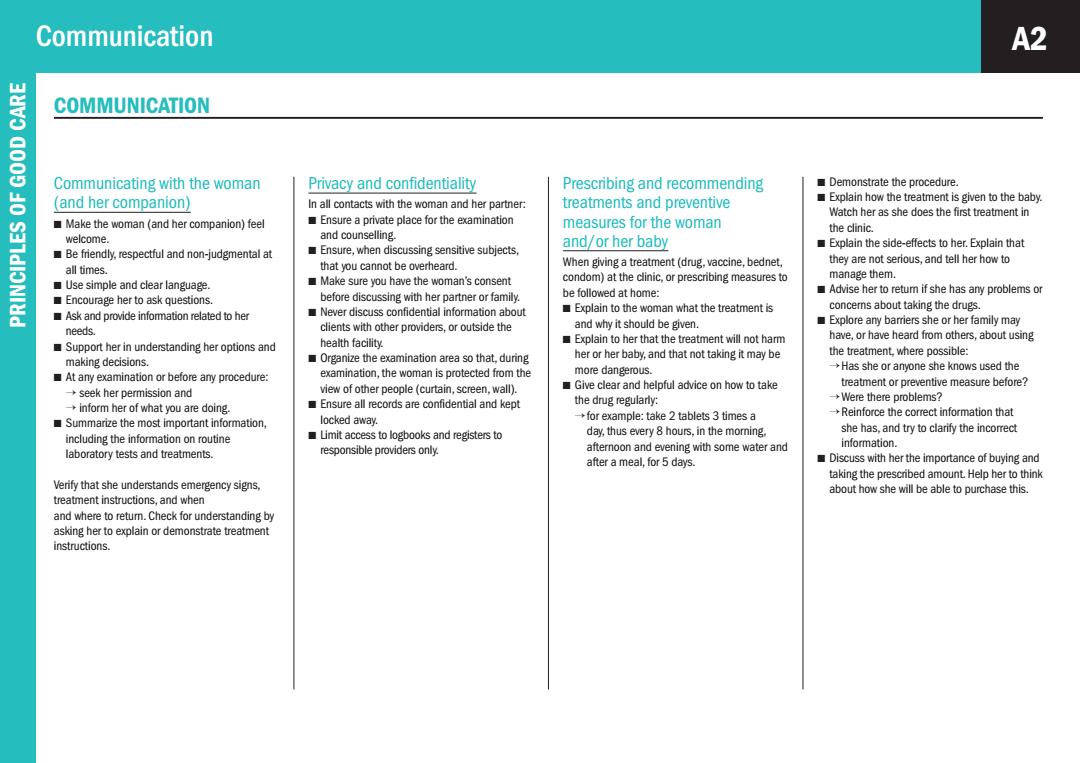正在加载图片...

Communication A2 38V0 COMMUNICATION 8 Communicating with the woman Privacy and confidentiality Prescribing and recommending Demonstrate the procedure. 告 (and her companion】 In all contacts with the woman and her partner: treatments and preventive ■E知lain how the treatment is given to the baby. Watch her as she does the first treatment in Make the woman(and her companion)feel Ensure a private place for the examination measures for the woman and counselling. the clinic. welcome. Be friendly,respectful and non-judgmental at Ensure,when discussing sensitive subjects, and/or her baby Explain the side-effects to her.Explain that they are not serious,and tell her how to 5 all times. that you cannot be overheard. When giving a treatment(drug,vaccine,bednet, Use simple and clear language. Make sure you have the woman's consent condom)at the clinic,or prescribing measures to manage them. before discussing with her partner or family. be followed at home: Advise her to retum if she has any problems or Encourage her to ask questions Explain to the woman what the treatment is concems about taking the drugs. Ask and provide infommation related to her Never discuss confidential information about Explore any bariers she or her family may needs. clients with other providers,or outside the and why it should be given. have.or have heard from others,about using Support her in understanding her options and health facility. Explain to her that the treatment will not harm the treatment where possible: making decisions. Organize the examination area so that,during her or her baby,and that not taking it may be At any examination or before any procedure: examination,the woman is protected from the more dangerous. Has she or anyone she knows used the view of other people(curtain,screen,wall). Give clear and helpful advice on how to take treatment or preventive measure before? seek her permission and inform her of what you are doing. Ensure all records are confidential and kept the drug regularly: →ere there problems? locked away. for example:take 2 tablets 3 times a Reinforce the correct information that Summarize the most important information, she has,and try to clarify the incorrect including the information on routine Limit access to logbooks and registers to day,thus every 8 hours,in the morning. afternoon and evening with some water and information. laboratory tests and treatments. responsible providers only. after a meal,for 5 days. Discuss with her the importance of buying and taking the prescribed amount.Help her to think Verify that she understands emergency signs, about how she will be able to purchase this. treatment instructions,and when and where to retum.Check for understanding by asking her to explain or demonstrate treatment instructions.Communication PRINCIPLES OF GOOD CARE A2 Communicating with the woman (and her companion) N Make the woman (and her companion) feel welcome. N Be friendly, respectful and non-judgmental at all times. N Use simple and clear language. N Encourage her to ask questions. N Ask and provide information related to her needs. N Support her in understanding her options and making decisions. N At any examination or before any procedure: ¡ seek her permission and ¡ inform her of what you are doing. N Summarize the most important information, including the information on routine laboratory tests and treatments. Verify that she understands emergency signs, treatment instructions, and when and where to return. Check for understanding by asking her to explain or demonstrate treatment instructions. Privacy and confidentiality In all contacts with the woman and her partner: N Ensure a private place for the examination and counselling. N Ensure, when discussing sensitive subjects, that you cannot be overheard. N Make sure you have the woman’s consent before discussing with her partner or family. N Never discuss confidential information about clients with other providers, or outside the health facility. N Organize the examination area so that, during examination, the woman is protected from the view of other people (curtain, screen, wall). N Ensure all records are confidential and kept locked away. N Limit access to logbooks and registers to responsible providers only. Prescribing and recommending treatments and preventive measures for the woman and/or her baby When giving a treatment (drug, vaccine, bednet, condom) at the clinic, or prescribing measures to be followed at home: N Explain to the woman what the treatment is and why it should be given. N Explain to her that the treatment will not harm her or her baby, and that not taking it may be more dangerous. N Give clear and helpful advice on how to take the drug regularly: ¡ for example: take 2 tablets 3 times a day, thus every 8 hours, in the morning, afternoon and evening with some water and after a meal, for 5 days. N Demonstrate the procedure. N Explain how the treatment is given to the baby. Watch her as she does the first treatment in the clinic. N Explain the side-effects to her. Explain that they are not serious, and tell her how to manage them. N Advise her to return if she has any problems or concerns about taking the drugs. N Explore any barriers she or her family may have, or have heard from others, about using the treatment, where possible: ¡ Has she or anyone she knows used the treatment or preventive measure before? ¡ Were there problems? ¡ Reinforce the correct information that she has, and try to clarify the incorrect information. N Discuss with her the importance of buying and taking the prescribed amount. Help her to think about how she will be able to purchase this. COMMUNICATION